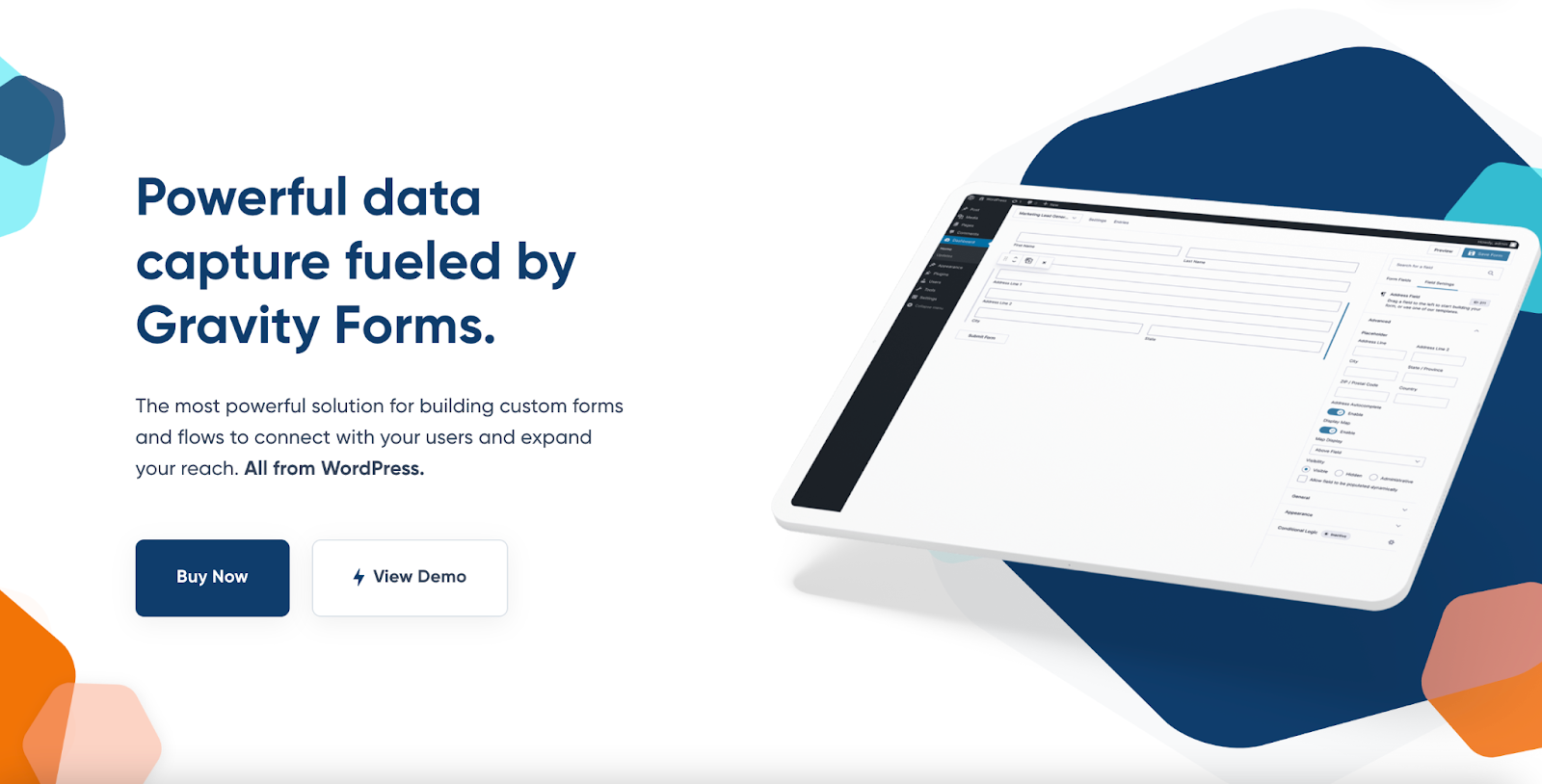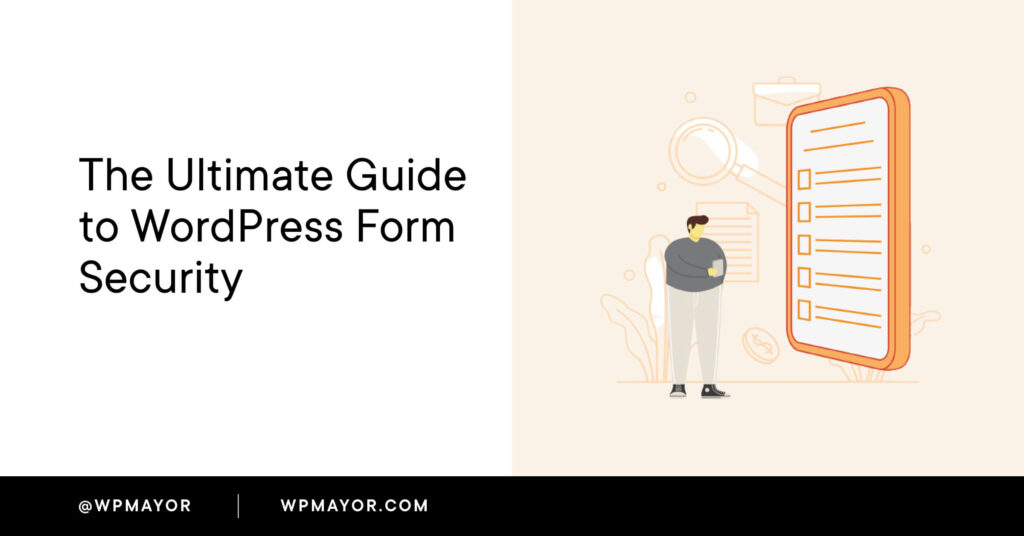[ad_1]
In today’s digital world, cyberattacks have become a serious concern.
WordPress websites are frequently targeted by hackers, making it more important than ever to follow WordPress security best practices.
However, one aspect of a WordPress site that most people fail to secure is forms. Most websites utilize forms for registering users, taking payments, gathering customer data, and more; forms are an integral part of the web!
WordPress form security is important because forms constitute an access point allowing brands and customers to exchange information. In fact, WordPress recently had to issue a forced security update for a critical vulnerability found in the popular Ninja Forms plugin! This should illustrate just how important form security is.
In this post, we’ll look at all the ways to ensure that your WordPress forms remain secure and invulnerable to hackers. Keep reading to find out more!

Securing Your Web Server and WordPress Install
WordPress form security depends, in large part, on the security of your web server and WordPress installation.
A website is an interconnected platform where a vulnerability in one area can affect other areas as well. Here’s an overview of some important security practices for WordPress sites:
Choose a Reliable Managed Hosting Provider
Unless you’re running your own server, there’s no reason you should have to learn the intricacies of hardening WordPress, keeping your PHP version up to date, and maintaining a secure web server. Rather, invest a bit more in a reliable managed hosting provider who can handle all of this for you.
In their documentation, WordPress themselves stress this point:
The web server running WordPress, and the software on it, can have vulnerabilities. Therefore, make sure you are running secure, stable versions of your web server and the software on it, or make sure you are using a trusted host that takes care of these things for you.
Ensure Your Website Has a Valid SSL Certificate
SSL stands for Secure Sockets Layer, which is the standard web protocol used to safeguard information between two systems.
Installing a valid SSL certificate on your website ensures that all client-server communications are encrypted. This adds an extra layer of security, helping to keep your website safe from intruders.
Keep WordPress Up to Date
The WordPress team takes security very seriously. That’s why WordPress is constantly being updated to patch bugs and fix new security vulnerabilities. However, in order to benefit from these fixes, you need to ensure that your version of WordPress is always up to date.
Older versions of WordPress are not maintained for security. Even the Reuters Blogging Platform was hacked due to an outdated version of WordPress!
Install a Security Plugin
While WordPress does a great job of keeping things secure, sometimes you need additional security features to give you peace of mind that your website won’t be compromised.
In this case, it’s a good idea to install a WordPress security plugin. The best security plugins out there include Malcare, iThemes, and Wordfence.
Choosing a Reputable Form Plugin
Perhaps the most important aspect of WordPress form security is choosing a reputable and well-supported form plugin. While there are several popular WordPress form plugins out there, not all of them are made equal when it comes to security.
The plugin you choose should…
- Be updated frequently by a dedicated team of developers
- Be endorsed by its users
- Have a proven track record in the WordPress community
While it’s not the only choice out there, a plugin that fulfills all of these requirements is Gravity Forms (which has been a mainstay in the WordPress ecosystem for over 14 years!). The Gravity Forms ecosystem also includes a number of certified developers who build powerful Gravity Forms add-ons and extensions.

Web Form Security Best Practices
Now let’s turn our attention to web form security best practices for WordPress. Here are some things you can do now to increase the security of your WordPress forms.
Keep Your Form Plugin Up to Date
As with WordPress itself, it’s important to keep your form plugin up to date. Developers are always working to fix potential security vulnerabilities in their plugins. These fixes are released in updates that you can install from within your WordPress Admin dashboard.
Some form plugins, like Gravity Forms, allow you to enable automatic background updates. This ensures that updates containing important security patches and bug fixes will install automatically without you having to do anything.
Limit User Permissions
When giving registered users on your site access to your forms, it’s not necessary to give them permission to perform any function related to your forms. As a general rule, it’s a good idea to assign only the capabilities needed by the user and no more.
For example, not all users require the ability to delete form submissions, install updates or edit existing entries. While there’s no way to manage user capabilities within WordPress itself, you can do this using a plugin like Members.
Mitigate Form Spam
Form spam is mostly just an annoyance, but it can become a security issue if it gets out of hand. Spam submissions also often include harmful links to phishing websites or sites that download malware. Eliminating form spam is an important aspect of WordPress form security.
Here are some proven ways to mitigate form spam:
- Add a CAPTCHA field to your form (such as Google reCAPTCHA) – A form CAPTCHA is a field that requires users to check a box or identify certain images from a selection to prove they are a human and not a bot.
- Include a honeypot field in your form to catch spam bots – A honeypot is a hidden field that only bots can see. When a form is submitted and the honeypot field contains data, you know it was submitted by a spam bot.
- Use conditional logic to hide the “Submit” button – While hiding the Submit button until some condition is met can be an effective way to mitigate spam, it’s not the best solution from an accessibility standpoint. (You can find more expert accessibility advice here.)
- Install a third-party anti-spam plugin like Akismet – Although anti-spam solutions like Akismet aren’t free, the cost may be worthwhile if you’re drowning in spam entries.
Of course, another way to prevent form spam is to ensure that only trusted users have access to your forms in the first place.
Restrict Access to Your Forms
There are ways to configure your forms so they only display to logged-in users. Limiting access to your forms can help thwart spam submissions and attempted security breaches. Some form plugins will include this functionality. If yours does not, you can use a plugin like Members to hide certain pages or content from regular site visitors.
Secure Your File Upload Fields
Many forms contain a file upload field that allows users to attach documents, images, and other files to their form submissions. However, if implemented incorrectly, file upload functionality can be open to exploitation. That’s why proper measures should be taken to secure your file upload fields.
Some ways that hackers exploit file upload fields include executing DDoS (Denial of Service) attacks by uploading many large files at once, uploading files with dangerous extensions, and uploading files that contain malware.
Here are some tips for securing your file upload fields:
- Require users to be logged in before they can upload files.
- Specify “allowed” file extensions (for example, if you want users to upload images, you could restrict file extensions to .png, .jpg, and .webp only).
- Ensure files are uploaded to a secure location on your server
- Set a maximum file size for uploaded files.
- Ensure that you do not share the file upload folder path with anyone other than site administrators.
Disable Page Caching for Forms That Are Dynamically Populated
If you have a form on your website that makes use of dynamic field population to prefill form fields with information related to a specific user, or other sensitive information, then you should disable caching for the page where that form is embedded.
If you don’t disable caching, then dynamic fields may not populate correctly and may even show data from previous users. It goes without saying that exposing user information is a serious security issue and a flagrant breach of trust.
Caching, if you’re unfamiliar with the term, is the processing of storing dynamic data in a cache, making it quicker to access. Some hosts utilize server-side caching to speed up page load times. There are also several popular WordPress caching plugins that help to speed up your site.
If you’re unsure whether your site is being cached, you can check using a free online tool, like this page cache test offered by SEO Site Checkup.

Secure Your WordPress Forms Now
Whether used for taking payments, registering new users, or gathering survey data, forms are a ubiquitous part of the internet and an integral aspect of most websites.
Forms represent a gateway for information exchange between website visitors and web servers. That’s why they are often targeted by hackers and malicious actors who seek to exploit security vulnerabilities and get their hands on sensitive information.
Luckily, there are things you can do to mitigate vulnerabilities and ensure that your forms remain secure.
In this post, we explored WordPress form security in-depth, showing you several ways to protect your website and your forms from those with malicious intent.
[ad_2]
Source link


